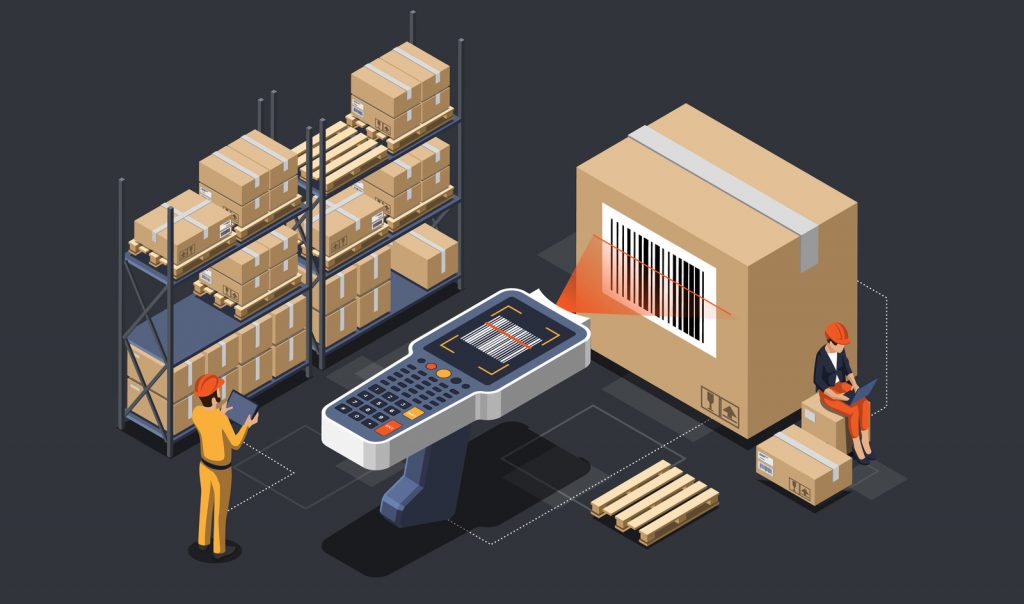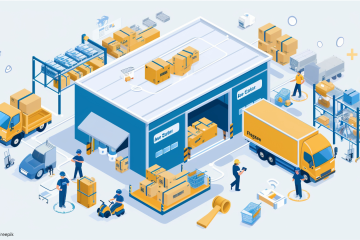With the heightened effects of Covid-19, unknown faults in the system can cause costly results – which is why supply chain visibility is needed more than ever.
In a recent survey by SCMR, respondents declared that strengthening relationships and increasing transparency with buyers and sellers is their primary strategy.
Supply chain visibility is most successful when there is a synergy between all of its components. From suppliers to customers, it is ensuring that the movement of goods and services, along with the channeling of information, is visible to everyone.

This article aims to understand the meaning of supply chain visibility, shed light on its value, and identify the steps that can be taken to achieve it.
What is Supply Chain Visibility?
Supply chain visibility (SCV) is a strategy that businesses practice in keeping track of their inventory across all levels. It also entails the ability to locate individual components and final products as they are in transit from the supplier to the customer.
Ultimately, the goal of supply chain visibility is to improve efficiency by making information accessible to everyone involved, including the customer.
The integration of SCV tools provides businesses with real-time data that can help them identify inventory changes, track product deliveries, reduce wastage, and minimise logistical errors.
5 Reasons Why Supply Chain Visibility is Important
End-to-end supply chain visibility is a vital component to have in your business strategy. It provides you with a competitive advantage of knowing the ins-and-outs of your operations.
Supply Chain Management (SCM) is Becoming More Complex
Modern supply chains are becoming increasingly complex and global. Businesses typically employ an extensive network of logistics partners and resources that are scattered across multiple cities and countries.
With customer demand for immediate delivery at an all-time high, there’s an increasing pressure to meet these expectations.
Supply chain visibility allows businesses to accurately track all this network activity..
A solid SCM strategy is integral in ensuring that all of these entities can communicate clearly with one another – making sure that the flow of information from one point to the next occurs as seamlessly as possible.
Better Control Over Your Inventory
One of the biggest headaches businesses face is the lack of insight into their inventory levels.
Due to messy supply chain management and outdated methods, it is common to rely on approximations to keep track of their inventory levels.
This results in over or under-stocked products, compromised customer relationships, and an overall dent in productivity.
SCV technology mitigates all of this by allowing businesses to effectively manage their inventory levels through automation and data.

This means businesses can effectively track inventory movement in real-time and make better decisions in replenishing products, meeting customer demand, and responding to marketplace trends.
Improved Customer Experience
86% of buyers are willing to pay more for excellent customer experience.
Technologically adept and unyielding in their demand for high-quality service, customers are more selective than ever. And for many of them, their experience as consumers inform their expectations as B2B buyers.
Supply chain visibility allows you to meet these expectations by monitoring your inventory movement -making sure that you always have the right products at the right time and location.
A comprehensive overview of your supply chain puts you in a position to consistently monitor and adapt to rising issues. This means you can easily update your customers to avoid any unpleasant surprises.
Minimise Risk
A major perk of gaining visibility into your supply chain is that you can reduce risks, while continuing to to grow your business using intelligent data and insights.
Supply chain visibility helps businesses protect themselves from unwarranted problems and blindspots, such as having a product go out-of-stock at the last minute.
Visibility lets business owners forecast demand and recognise the lead time required in the procurement of certain products.
Reduced Costs
A study from 2018 revealed that 62% of businesses suffered financial losses due to supply chain disruptions. A full supply chain visibility can eliminate the struggle between efficiency and hidden expenses that are eating away at your budget.
Having a big picture overview means you can precisely allocate resources where it’s needed to avoid unnecessary spending.
Data from supply chain visibility can help to reduce costs in areas such as storage, inventory, labour, material and transportation.
Companies have also recognised that reducing supply chain costs lead to increased spending amongst their customers. In other words, the more you can help your customer save in areas such as shipping, the more they can spend on your products.
How to Increase Supply Chain Visibility
A reliable supply chain visibility action plan should focus on three core components: demand, resources and efficiency.
We’ve put together a 5-step guide on what businesses can do to achieve end-to-end visibility to ensure your supply chain operates as efficiently as possible.
Step 1: Identify Your Definition of Visibility
First, define what visibility means to you and to your customers. Think about the types of problems you want to resolve and what you want to accomplish with greater visibility.
- How quickly do you want to respond to change?
- Do you want to zero-in on potential threats to your business?
- How can you leverage data to improve customer experience?
These answers will inform the decisions you make to implement the best SCV strategy for your business.
Next, think about visibility and your customers. Most customers today expect to track their items the minute they place an order. They want real-time delivery updates, especially in an increasingly omnichannel ecosystem. As a business, you need to make sure all of this is accessible to your customers.
Step 2: Do Away with Data Silos
A data silo happens when only select users or teams have access to a set of information that everyone else doesn’t. This restriction on data visibility hinders you from accomplishing full supply chain visibility.
Not only does it undercut productivity but it also leads to costly mistakes.
When people and departments within your company don’t have access to the same data, it can lead to events such as decision-making based on inaccurate data, workflow gaps, and a decrease in collaboration between internal departments.
Remember, to fix an issue, you have to know what you don’t know.
Step 3: Build A Collaborative Network
Reach out to your network! From suppliers to distributors, speak to your key vendors to identify pain points, and find out how to incorporate an SCV strategy that can streamline processes.

As more companies begin to rely on external vendors to provide them with services ranging from the supply of raw materials to logistics, the need for trustworthy and resilient partnerships is crucial.
Focus on achieving a win-win situation that is beneficial to everyone involved.
Step 4: Invest in the Right Tech Talent
Hiring the right people to manage and interpret your data is just as important as investing in the right tech solutions. Recruiting the best people for the job will let you maximise your tech’s capabilities. It will also save you time and resources in the long run.
However, before you invest in your tech and the talent needed to support it, do a quick audit of your existing systems to determine what areas of improvement. Wherever possible, implement automation to expedite work processes.
Step 5: Measure Your Data
Once you’ve got a data system that you trust to make effective decisions, now is the time to get granular.
Determine what is most important for you to track and consistently monitor your findings to ensure that the improvements you make are continuous and responsive.

Supply chain visibility is an ongoing process so having a project plan is crucial in maintaining the level of the desired efficiency.
Having a structured plan allows you to utilise your data in the most productive manner and functions as a central point of reference for all decision-making.
Trends Informing Supply Chain Visibility
As advancements in technology make waves across B2B industries, the supply chain is one of the most heavily impacted sectors.
It involves heavy reliance on manual processing and large data sets that are often stored in multiple places.
The latest trends in SCV are focused on heightening the customer experience and the streamlining of work processes to increase efficiency and reduce costs.
Customer Visibility
One of the most game-changing innovations to impact the world of e-commerce is the level of transparency in online shopping.
When an order is placed, customers can expect to receive real-time updates on the status of their order up until it reaches their doorstep.
Customer expectations for connectivity and transparency is higher than ever andthey are accustomed to being kept in the loop at every point of the journey.
As the marketplace becomes more competitive, businesses need to fulfill the demand for real-time visibility to maintain customer satisfaction and retention.
Digitisation is Key
Digitisation touches every element of the supply chain. It is needed to redesign logistics practices to be more responsive and efficient, and give businesses the right tools to compete in a continuously evolving, omnichannel environment.
More companies are redesigning their supply chain to fully integrate digital solutions to manage inventory, monitor stock levels and eliminate human error.
By embracing digitisation, businesses can expect improved agility in their supply chain operations. This will let them create better customer experiences and generate higher revenue.
SaaS and the Supply Chain
The rise in cloud computing is gaining momentum and this trend comes hand-in-hand with Software as a Service (SaaS) in the realm of supply chain technology.
A major contributor to SaaS’s popularity is tied to its convenience (you only pay for the services you need) and its versatility (you can personalise your software to only include components that are relevant to you and your business).
SaaS also provides companies with an added layer of security,and because it is often outsourced to expert service providers, getting support is often a synch. You also save on the costs of having to hire an entire IT department to manage your backend system.
Next Steps to Achieving Supply Chain Visibility
Ultimately, the desire to create memorable customer experiences and maximise efficiency is what fuels the quest for supply chain visibility.
A clear action plan and implementation of the correct technology has to be prioritised to bring this goal to life.
For businesses in Malaysia, Dropee is an e-commerce solutions platform that aims to support local businesses in their quest for efficiency and digitisation.
Whether you’re looking to connect better with your customers or want to streamline your inventory management, our goal is to provide you with the right technology at every step of your growth. Reach out to us today for a free consultation and let’s get started!


0 Comments